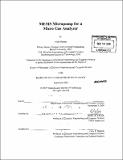| dc.contributor.advisor | Martin A. Schmidt. | en_US |
| dc.contributor.author | Sharma, Vikas, 1979- | en_US |
| dc.contributor.other | Massachusetts Institute of Technology. Dept. of Electrical Engineering and Computer Science. | en_US |
| dc.date.accessioned | 2010-04-28T17:13:55Z | |
| dc.date.available | 2010-04-28T17:13:55Z | |
| dc.date.copyright | 2009 | en_US |
| dc.date.issued | 2009 | en_US |
| dc.identifier.uri | http://hdl.handle.net/1721.1/54643 | |
| dc.description | Thesis (Ph. D.)--Massachusetts Institute of Technology, Dept. of Electrical Engineering and Computer Science, 2009. | en_US |
| dc.description | Cataloged from PDF version of thesis. | en_US |
| dc.description | Includes bibliographical references (p. 164-177). | en_US |
| dc.description.abstract | This thesis presents a MEMS micro-vacuum pump designed for use in a portable gas analysis system. It is designed to be pneumatically-driven and as such does not have self-contained actuation (the focus of future work). This research was carried out through a series of modeling, design, fabrication, and experimental testing tasks. Non-linear stress modeling tools characterizing the structural deformations of the micropump pistons and tethers, and fluid-flow modeling tools characterizing the vacuum generation and pumping rates were developed. A systematic design procedure based on these tools enabled the design and prediction of different valve and pump layouts to satisfy the stress limitations, and flow and power consumption requirements set forth by the MIT Micro Gas Analyzer project. The micropumps were fabricated using MEMS fabrication techniques, comprised of silicon and pyrex micromachining and bonding. Fabrication challenges, in particular the deep-reactive ion etching (DRIE) of the drive pistons and membrane structures, were overcome, and a completely computer controlled pneumatic testing platform for the rapid characterization of valve and micropump performance at different actuation pressures and frequencies was developed. Valve leakage data for various valve designs was collected and compared with models, and a micropump capable of generating 258Torr of vacuum below atmosphere was demonstrated at 0.75Hz operation. The maximum frequency of operation for these devices was experimentally measured to be just above 2Hz, which was consistent with fluid flow models. | en_US |
| dc.description.abstract | (cont.) This thesis presents vacuum generating micropump performance that comparables well with the best published to date, and explores future micropump designs and modeling/testing approaches that could improve overall performance and bring us closer to meeting the specifications set forth by the MGA project. Finally, general guidelines for micropump design and fabrication for any application are also presented. | en_US |
| dc.description.statementofresponsibility | by Vikas Sharma. | en_US |
| dc.format.extent | 177 p. | en_US |
| dc.language.iso | eng | en_US |
| dc.publisher | Massachusetts Institute of Technology | en_US |
| dc.rights | M.I.T. theses are protected by
copyright. They may be viewed from this source for any purpose, but
reproduction or distribution in any format is prohibited without written
permission. See provided URL for inquiries about permission. | en_US |
| dc.rights.uri | http://dspace.mit.edu/handle/1721.1/7582 | en_US |
| dc.subject | Electrical Engineering and Computer Science. | en_US |
| dc.title | MEMS micropump for a Micro Gas Analyzer | en_US |
| dc.type | Thesis | en_US |
| dc.description.degree | Ph.D. | en_US |
| dc.contributor.department | Massachusetts Institute of Technology. Department of Electrical Engineering and Computer Science | |
| dc.identifier.oclc | 606578573 | en_US |
